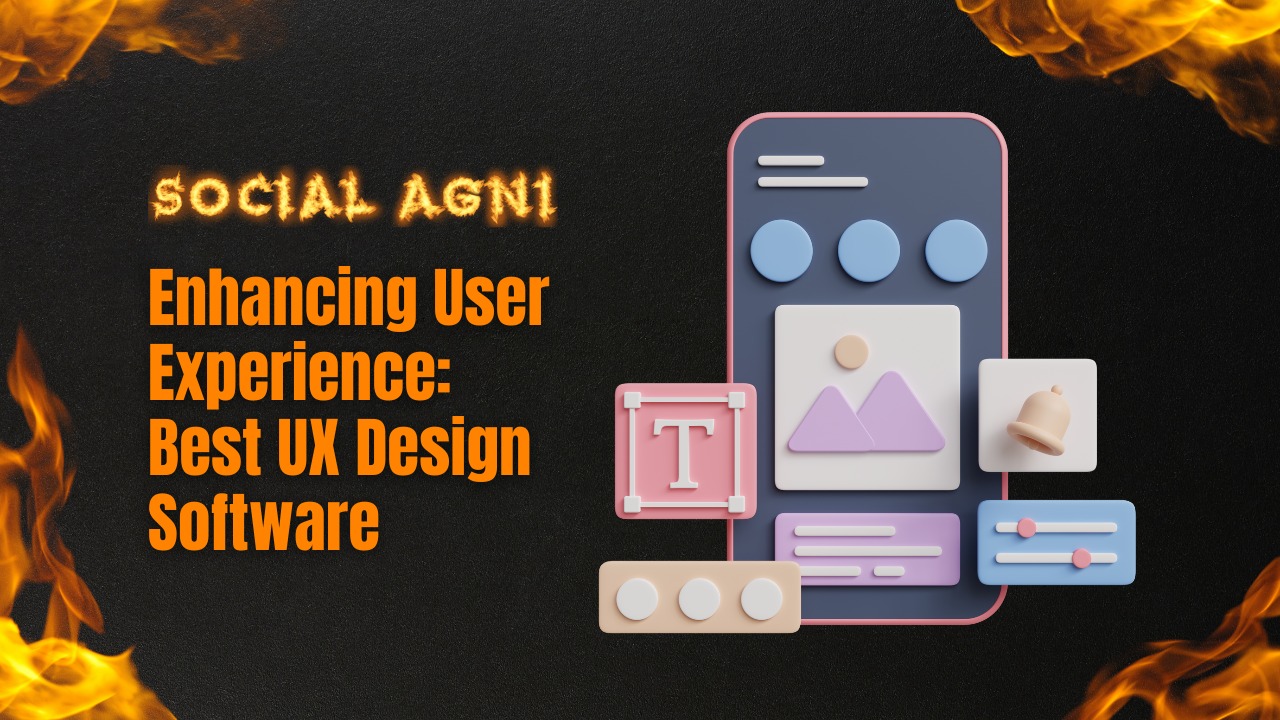UX is crucial to product success in today’s digital world. To engage consumers, build customer loyalty, and develop a business, a website, mobile app, or software must provide a smooth and intuitive user experience. UX design software is crucial to great UX. UX design software helps designers create user-centered and attractive interfaces. These software tools let designers prototype, wireframe, and enhance their designs using a wide range of capabilities. They streamline workflow, enable communication, and integrate with other design and development tools, helping teams operate efficiently.
UX software has several advantages. First, interactive prototypes let designers test and confirm their designs before development. This iterative method helps uncover usability issues, make adjustments, and provide a product that connects with the target audience. UX design software centralizes communication, feedback, and version control, promoting teamwork. It streamlines collaboration between designers, developers, and stakeholders to meet user experience goals.
UX design software commonly combines with usability testing technologies, giving designers useful insights into user interaction. Usability tests help designers discover pain areas, get user input, and make data-driven decisions to improve the user experience. This post will discuss how to choose the finest UX design tools and present some of the top options. Real-world case studies will show how these software solutions improve user experiences. We’ll also offer UX design software optimization advice.
This post will explain the importance of UX design software and how it may improve user experiences. Using UX design software will improve your design process and help you develop things that last.
I. Understanding UX Design Software
Understanding UX design software’s goal, essential features, and design process advantages is crucial to appreciating its worth. Let’s examine
A. Definition and Purpose of UX Design Software
UX design software helps designers create user-centered interfaces and optimize digital product user experiences. Its features and functions help designers envision, create, prototype, and enhance their concepts.
UX design software helps designers develop intuitive, attractive, and engaging user interfaces by streamlining the design process. It helps designers envision and test their ideas by turning them into interactive prototypes and wireframes.
B. Essential UX Design Software Features
Prototyping and Wireframing
UX design software lets designers generate interactive, clickable mockups. These capabilities let designers replicate user interactions, transitions, and animations to model the final product’s user experience.
Design Libraries and Assets
Many UX design software packages provide icons, UI components, and templates. By providing a framework for design aspects, these tools save time and effort.
Collaboration and Team Workflow
Real-time editing, commenting, and version control enable teamwork in UX design tools. These features promote smooth communication and cooperation between designers, developers, and stakeholders, resulting in a user-centric design process.
Responsive Design
Mobile devices require responsive design. UX design software lets designers develop adaptable layouts that adjust to varied screen sizes and devices, delivering a consistent and optimum experience across platforms.
Usability Testing
Many UX design software solutions contain usability testing tools to help designers evaluate their designs’ usability and effectiveness. Usability testing features detect pain points, usability concerns, and ways to improve user experiences.. UX Design Software Benefits
- UX design software helps designers develop intuitive, attractive, and user-friendly interfaces. It gives designers a variety of design and prototype tools to iterate, test, and improve their ideas to improve user experience.
- UX design software’s ready-to-use design materials, templates, and collaborative tools save time and money. Designers may focus on developing great user experiences without reinventing the wheel.
- UX design software helps designers, developers, and stakeholders collaborate. It centralizes design exchange, feedback, and coordination. Collaborative design iterations improve efficiency.
- UX design software lets designers visualize their ideas. Designers may improve interface usability by visualizing and testing design concepts early in the process.
II. Criteria for Selecting the Best UX Design Software
A smooth design process requires the correct UX design software. When choosing UX design tools, consider these criteria
A. User-Friendly Interface and Design Tools
Choose software with an intuitive interface and design tools. Designers should be able to rapidly understand the tools and start designing. Drag-and-drop, smart instructions, and a clear interface improve program usability.
B. Robust Prototyping and Wireframing Tools
Ensure the program supports prototyping and wireframing. Interactive components, transitions, and animations make prototypes lifelike. Simulating user experiences requires linking screens and defining interactions. To cover many design situations, the program should allow tap, swipe, scroll, and hover.
C. Teamwork & Collaboration
Consider software with extensive collaborative features to expedite design. Designers, developers, and stakeholders need real-time editing, commenting, and version control. Design sharing, annotations, and feedback gathering aid team collaboration.
D. Integration with Other Design and Development Tools
Make sure the UX design software works with other design and development tools. Integration with graphic design software, project management tools, design libraries, and prototyping platforms improves efficiency and workflow. Designers can quickly integrate assets, export designs, and collaborate across software systems.
E. Platform Compatibility and Responsiveness
Consider your design’s platforms and devices. Ensure the software supports web, mobile, and desktop design. It should let you develop responsive layouts for multiple screen sizes and resolutions. This enables uniform and accessible user experiences across devices and platforms.
F. Accessibility and Usability Testing
User experience requires accessibility. Find software that tests accessibility or interfaces with external tools. Consider usability testing software to acquire user feedback, perform user testing sessions, and evaluate user behavior to enhance design usability and effectiveness.
Try out UX design software to see whether it matches your demands. Read user reviews, visit online groups, and ask design professionals about the software’s pros and cons.
Read Also 15 Must-Have Plugins For Creating Killer Content Marketing Strategies
III. Top UX Design Software Solutions
There are several excellent UX design software options. Let’s examine some of the best ways to improve your design process and generate great user experiences
A. Adobe XD
A robust UX design and prototyping tool. It has a simple UI, powerful prototyping, and a seamless connection with Adobe Creative Cloud apps. Adobe XD lets designers build interactive prototypes with responsive scaling, repeat grids, and auto-animate. It also facilitates teamwork and stakeholder input.
B. Figma
This cloud-based design tool allows real-time editing and collaboration. It has vector editing, interactive components, and design libraries for design and prototyping. Figma is perfect for remote design collaboration since it allows numerous team members to work concurrently. Version control and comments improve cooperation and design iteration.
C. Sketch
The sketch is a popular macOS UX design tool known for its simplicity and plugin ecosystem. Design features include vector editing, symbol libraries, and prototyping. Sketch plugins let designers adjust workflow and interface with other design tools. Many UI designers utilize it.
D. InVision
InVision is a prominent UX prototyping and collaboration tool. Prototyping, animation, and user testing are available. InVision lets designers create interactive prototypes, get user input, and communicate with stakeholders in real-time. It works nicely with various design tools and streamlines design-to-development.
E. Axure RP
A complete UX design tool for wireframing, prototyping, and user flow generation. Its rich range of interactive and dynamic features lets designers construct realistic prototypes. Axure RP offers complicated interactions using conditional logic and variables. UX designers like its high-fidelity prototypes and documentation.
Each of these top UX design software tools has distinct features and capabilities. Consider your demands, team cooperation, budget, and design workflow while choosing software. To choose the finest design software, try demonstrations, trial editions, or free plans.
IV. Case Studies Real-World Examples of UX Design Software in Action
This section examines real-world case studies that show how UX design software improves user experiences and corporate goals. These examples show how UX design software has helped digital products succeed.
A. Case Study 1
Company X, an e-commerce platform, wanted to improve user experience to boost sales and engagement. Their design team used UX design software to produce interactive prototypes that emulated the user experience, identifying usability concerns and informing design decisions.
Company X tested interface layouts, navigation structures, and interactive features using UX design software’s prototyping capabilities. They improved their designs through user-testing prototypes. User comments improved the interface.
Company X’s indicators improved significantly. User engagement increased by 20%, bounce rates were reduced by 15%, and conversion rates improved by 10%. UX design software’s seamless collaboration capabilities let designers, developers, and stakeholders communicate and coordinate, speeding up the design process.
B. Case Study 2
Company Y, a mobile app company, wanted to design a user-centric app to stand out in a competitive market. Their design team cooperated and iterated using UX design tools, creating a great user experience.
The UX design tools let the team exchange assets, give input, and monitor design versions. This methodology streamlined design and guaranteed uniformity across screens and features.
Company Y used the software’s usability testing tools to gather vital user behavior and preference data. A more straightforward and engaging software was created by identifying pain areas and iteratively redesigning them based on user input.
The software was well-received and adopted quickly. UX design software helped collaborate, refine designs, and produce an engaging user experience that differentiated Company Y from rivals.
These cases show how UX design software improves user experiences and corporate goals. Interactive prototypes, collaboration, and usability testing aid the iterative design process, improving user interfaces and happiness.
V. Tips for Getting the Most Out of UX Design Software
Consider these UX design software tips to optimize advantages and create great user experiences
Master Software
Learn your UX design software’s capabilities and functions. Learn the software’s capabilities using tutorials, online courses, and learning materials. This lets you maximize your design process using all the tools.
Stay Current
UX design software is updated often. To take advantage of new features, performance improvements, and bug fixes, keep up with software upgrades. Keep up with the software’s community forums, blogs, and social media.
Collaborate Effectively
Use UX design software’s collaborative capabilities to improve communication and teamwork. Design with designers, developers, product managers, and consumers. Open communication, feedback, and many viewpoints produce a comprehensive, user-centered design.
Conduct Usability Testing
Use UX design software’s usability testing capabilities or external tools. Real users may provide useful feedback and evaluate your designs. Iterate using customer feedback to improve the user experience.
Use Design Libraries and Templates
UX design software offers design libraries, UI components, and templates. Use these tools to speed up and standardize your design. However, customize these features to fit your project and brand guidelines.
Embrace Responsive Design
Design responsive interfaces for diverse screen sizes and devices. Use your UX design software’s responsive design tools to develop layouts that improve user experience across platforms.
Iterate
Ask users, stakeholders, and other designers for input throughout the design process. Adopt an improvement culture. A/B test, analyze user behavior and use data to improve the user experience.
Explore Integrations
Find complementary design and development tools for your UX design software. Graphic design, prototyping, project management, and collaborative software are examples. Seamless interconnections improve workflow and productivity.
Engage with the Community
Join UX design networks, forums, and online organizations for your program. Engaging with the community lets you learn, contribute, and keep up with industry trends and best practices.
These ideas will help you utilize UX design software to create amazing user experiences that exceed expectations.
Conclusion
For better user experiences and profitable digital goods, use the best UX design software. Understanding the criteria for choosing the finest software, such as simplicity of use, robust prototyping, collaborative features, integration possibilities, platform compatibility, and accessibility testing, is essential. We saw how the top UX design software products have improved user experiences and driven corporate success by examining real-world case studies. Designers may iterate and refine their ideas using interactive prototypes, collaborative tools, and usability testing to develop user-centric interfaces and higher user satisfaction.
Master the software, stay up to date, collaborate with stakeholders, conduct usability testing, use design libraries and templates, embrace responsive design, seek feedback and iterate, explore integrations with other tools, and engage with the design community to get the most out of UX design software. Designers may utilize UX design software to create amazing user experiences that exceed user expectations by following these principles. Remember, the ultimate aim is to develop simple, engaging, and user-friendly designs that make a lasting impression on customers and generate digital product success.
Frequently Asked Questions (FAQS)
1. UX design software?
Designers utilize UX design tools to build and optimize user interfaces. Prototyping, wireframing, collaboration, and usability testing expedite the design process and improve user experience.
2. UX design software benefits?
UX design software improves design efficiency, creates interactive prototypes, facilitates team collaboration, gathers user feedback through usability testing, and creates aesthetically beautiful and user-friendly interfaces.
3. UX design software for online and mobile?
Many UX design tools enable online and mobile design. They enable responsive layouts and optimization for varied screen sizes and resolutions, guaranteeing consistent user experiences across devices.
4. Popular UX design software?
Many UX design tools enable online and mobile design. They enable responsive layouts and optimization for varied screen sizes and resolutions, guaranteeing consistent user experiences across devices.
5. UX design software: compatible with other design tools?
UX design software integrates with graphic design applications like Adobe Creative Suite, prototyping platforms, project management tools, and design libraries. Integrations improve the design process and efficiency.
6. UX design software for teamwork?
UX design software needs collaborative features. Real-time editing, commenting, version control, and design sharing let designers, developers, and stakeholders collaborate.
7. Usability testing using UX design software?
UX design software generally incorporates or combines usability testing tools. Designers may perform user testing, gather feedback, and analyze user behavior to uncover usability concerns and make data-driven design decisions to improve the user experience.
8. UX design software demos?
Yes, many UX design software solutions provide free samples or demos so consumers may try out the program before buying. Use these trials to assess the software’s fit for your needs.
9. UX software for beginners?
UX design software is beginner-friendly and has a minimal learning curve. Tutorials, manuals, and internet resources assist newcomers learn the program.
10. UX design software cost?
Features, licenses (individual or team), and subscription plans (monthly or annual) affect UX design software prices. Basic versions and trial periods are free, but advanced features and professional use need a monthly or annual subscription.




















